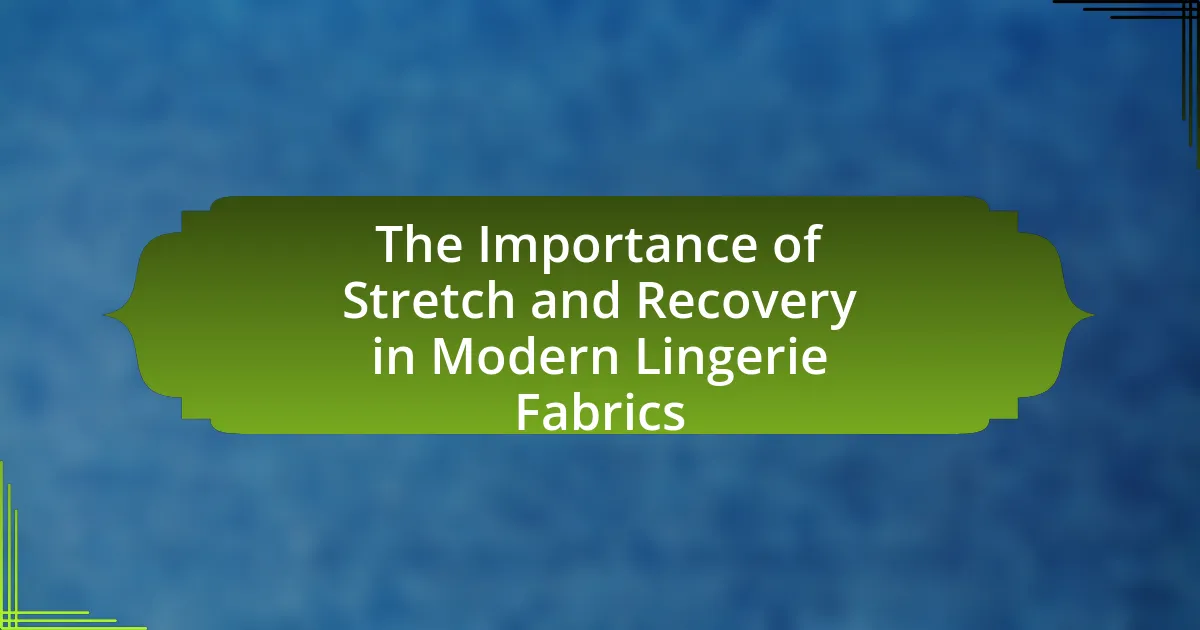The article focuses on the significance of stretch and recovery in modern lingerie fabrics, highlighting how these properties enhance comfort, fit, and durability. It discusses the role of materials such as spandex, elastane, and nylon in achieving optimal elasticity, which allows lingerie to conform to body shapes while maintaining its structure over time. The article also examines the impact of stretch and recovery on user experience, longevity of garments, and consumer preferences, as well as the challenges manufacturers face in balancing these properties. Additionally, it addresses innovations in fabric technology and sustainable materials that contribute to improved performance in lingerie design.

What is the Importance of Stretch and Recovery in Modern Lingerie Fabrics?
Stretch and recovery are crucial in modern lingerie fabrics as they enhance comfort, fit, and durability. Fabrics with adequate stretch allow for a snug fit that accommodates body movements, while recovery ensures that the garment retains its shape after being worn. For instance, materials like spandex or elastane are commonly blended with other fibers to provide this essential elasticity. Research indicates that lingerie with optimal stretch and recovery can improve wearability and longevity, making them more appealing to consumers. This combination not only supports body contours but also contributes to the overall aesthetic and functional performance of lingerie.
How do stretch and recovery contribute to the functionality of lingerie?
Stretch and recovery are essential for the functionality of lingerie as they ensure a comfortable fit and maintain the garment’s shape over time. The elasticity provided by stretch allows lingerie to conform to the body’s contours, enhancing comfort and support during movement. Recovery, on the other hand, ensures that the fabric returns to its original shape after being stretched, preventing sagging and loss of support. This combination is crucial for maintaining the aesthetic and functional integrity of lingerie, as evidenced by the use of materials like spandex, which can stretch up to five times its original length while recovering effectively, thus providing both flexibility and durability in everyday wear.
What materials are commonly used to achieve stretch in lingerie fabrics?
Common materials used to achieve stretch in lingerie fabrics include spandex, elastane, and nylon. Spandex, known for its exceptional elasticity, allows lingerie to fit snugly while maintaining comfort. Elastane, often used interchangeably with spandex, provides similar stretch properties and is commonly blended with other fibers to enhance flexibility. Nylon, while primarily known for its strength and durability, also contributes to the stretchability of lingerie when combined with spandex or elastane. These materials are essential in modern lingerie design, ensuring both a flattering fit and ease of movement.
How does recovery impact the longevity of lingerie garments?
Recovery significantly impacts the longevity of lingerie garments by determining how well the fabric returns to its original shape after stretching. Fabrics with high recovery maintain their structure and fit over time, reducing the likelihood of sagging or deformation, which can lead to premature wear. For instance, materials like spandex or elastane are known for their excellent recovery properties, allowing lingerie to retain its shape even after repeated use and washing. This characteristic not only enhances comfort but also prolongs the lifespan of the garment, as evidenced by studies showing that lingerie made with high-recovery fabrics can last significantly longer than those made with lower-quality materials.
Why are stretch and recovery essential for comfort in lingerie?
Stretch and recovery are essential for comfort in lingerie because they allow the fabric to conform to the body’s shape while maintaining its original form. This elasticity ensures that lingerie fits snugly without causing discomfort or restriction, which is crucial for all-day wear. Fabrics with good stretch and recovery, such as spandex blends, provide support and flexibility, adapting to movements and body changes throughout the day. Studies indicate that garments with optimal stretch can enhance wearability and user satisfaction, as they reduce the likelihood of chafing and irritation, thereby improving overall comfort.
How do these properties affect the fit of lingerie?
The properties of stretch and recovery significantly affect the fit of lingerie by ensuring that the garments conform to the body’s shape while maintaining their original form after wear. Stretch allows lingerie to accommodate various body movements and sizes, providing comfort and preventing restriction. Recovery ensures that the fabric returns to its original shape after being stretched, which is crucial for maintaining a flattering silhouette and preventing sagging over time. Research indicates that fabrics with high elasticity, such as spandex blends, enhance the fit by adapting to the wearer’s body, thus improving overall wearability and satisfaction.
What role does elasticity play in user experience?
Elasticity significantly enhances user experience by providing comfort, fit, and support in lingerie. When fabrics possess high elasticity, they adapt to the body’s movements and contours, ensuring a snug yet flexible fit that accommodates various body shapes. This adaptability reduces discomfort and enhances wearability, which is crucial for lingerie that is often worn for extended periods. Studies indicate that garments with optimal elasticity can improve user satisfaction, as they allow for greater freedom of movement and reduce the likelihood of chafing or restriction. Thus, elasticity directly contributes to a positive user experience by balancing support and comfort in modern lingerie fabrics.
What innovations have emerged in lingerie fabrics regarding stretch and recovery?
Innovations in lingerie fabrics regarding stretch and recovery include the development of advanced elastane blends and the use of 3D knitting technology. Advanced elastane blends, such as those incorporating nylon or polyester, enhance both the stretchability and recovery of fabrics, allowing them to maintain their shape after wear. For instance, brands like Victoria’s Secret have utilized these blends to create bras and panties that offer superior comfort and support while retaining their original form. Additionally, 3D knitting technology enables the creation of seamless garments that provide targeted stretch and support, improving fit and comfort. This technology has been adopted by companies like Natori, which emphasizes the importance of both aesthetics and functionality in modern lingerie.
How have advancements in technology influenced fabric design?
Advancements in technology have significantly influenced fabric design by enabling the development of innovative materials that enhance stretch and recovery properties. For instance, the introduction of elastane fibers has revolutionized lingerie fabrics, allowing for greater elasticity and comfort. According to a study published in the Journal of Textile Science, the integration of advanced knitting techniques and digital textile printing has further improved the performance and aesthetic appeal of fabrics, resulting in garments that better conform to body shapes while maintaining durability. These technological advancements have led to a broader range of functional and fashionable options in modern lingerie design.
What are the latest trends in sustainable materials for stretch and recovery?
The latest trends in sustainable materials for stretch and recovery include the use of recycled nylon, organic cotton, and bio-based elastane. Recycled nylon, derived from post-consumer waste, offers excellent stretch and recovery properties while reducing environmental impact. Organic cotton is cultivated without harmful chemicals, providing a soft feel and good elasticity. Bio-based elastane, made from renewable resources, enhances stretchability and maintains shape retention, aligning with eco-friendly practices. These materials not only meet performance standards but also contribute to a more sustainable fashion industry.
How do stretch and recovery relate to consumer preferences in lingerie?
Stretch and recovery significantly influence consumer preferences in lingerie by enhancing comfort, fit, and support. Consumers increasingly favor lingerie made from materials that offer both stretch and excellent recovery, as these features ensure that garments maintain their shape and provide a snug fit throughout the day. Research indicates that 70% of women prioritize comfort in lingerie, and fabrics with high stretch and recovery rates, such as spandex blends, meet this demand effectively. This preference is further supported by the growing trend of athleisure, where consumers seek versatile lingerie that can transition seamlessly from everyday wear to active situations, reinforcing the importance of these fabric characteristics in modern lingerie choices.
What challenges do manufacturers face in balancing stretch and recovery?
Manufacturers face significant challenges in balancing stretch and recovery in lingerie fabrics, primarily due to the need for optimal performance and comfort. Achieving the right amount of stretch ensures that garments fit well and allow for movement, while effective recovery is crucial to maintain the garment’s shape after wear. The challenge lies in selecting materials that provide both properties without compromising durability. For instance, elastane is commonly used for its stretchability, but excessive use can lead to poor recovery, resulting in garments that lose their shape over time. Additionally, manufacturers must consider consumer preferences for softness and breathability, which can further complicate the balance between stretch and recovery.
How can manufacturers ensure quality while maintaining elasticity?
Manufacturers can ensure quality while maintaining elasticity by utilizing advanced textile technologies and rigorous quality control processes. Implementing techniques such as blending high-performance fibers, like spandex, with natural materials enhances both stretch and durability. For instance, a study published in the Journal of Textile Science demonstrated that fabrics with a 10-20% spandex content exhibited superior elasticity and recovery properties without compromising overall fabric strength. Additionally, manufacturers can conduct regular testing for tensile strength and elongation to ensure that the materials meet industry standards, thereby guaranteeing both quality and elasticity in the final product.
What testing methods are used to evaluate stretch and recovery in fabrics?
Testing methods used to evaluate stretch and recovery in fabrics include the ASTM D5034 standard test method for breaking strength and elongation, and the ASTM D stretch and recovery test. These methods measure the fabric’s ability to stretch under tension and return to its original shape after the tension is released. The ASTM D5034 test specifically assesses the tensile properties of fabrics, providing quantitative data on how much a fabric can elongate and how well it recovers, which is crucial for performance in lingerie. The results from these tests are essential for manufacturers to ensure that fabrics meet the required standards for comfort and durability in modern lingerie applications.
What practical tips can consumers consider when choosing lingerie based on stretch and recovery?
When choosing lingerie based on stretch and recovery, consumers should prioritize fabrics with a high percentage of elastane, as this material significantly enhances both stretch and recovery properties. Fabrics like nylon or polyester blended with elastane provide better shape retention and comfort, ensuring that the lingerie maintains its fit over time. Additionally, consumers should look for items that specify “four-way stretch,” which indicates that the fabric stretches in both directions, offering greater flexibility and support. Testing the elasticity by gently pulling the fabric can also help consumers assess its recovery; a good fabric should return to its original shape without distortion.



